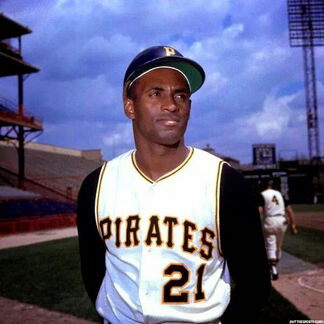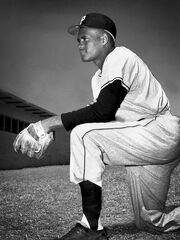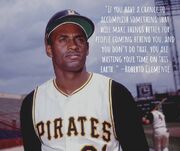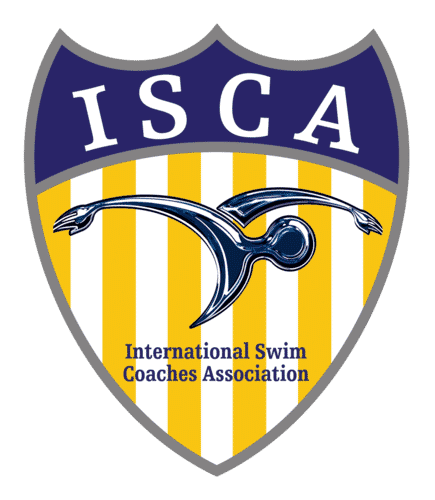
Roberto Clemente, #21, Pittsburgh Pirates, often called, The Great One.
Background[]
Great baseball player for the Pittsburgh Pirates from Puerto Rico (also known as PUR) ![]() who died on a humanitarian trip.
who died on a humanitarian trip.
Links[]

Clemente (Estrella 21) - Un Tributo Musical
Tribute Video
Media[]
- Cover story in the Pittsburgh City Paper, newsweekly, about a new graphic book on Roberto Clemente
http://digital.turn-page.com/issue/28641

Roberto Clement at 1956 preseason.
| This page uses Creative Commons Licensed content from Wikipedia (view authors). |
Details[]

Template:Infobox MLB player Roberto Clemente Walker (August 18, 1934 – December 31, 1972) was a Puerto Rican Major League Baseball right fielder. He was born in Carolina, Puerto Rico, the youngest of seven children. On November 14, 1964, he married Vera Zabala at San Fernando Church in Carolina. The couple had three children: Roberto Jr., Luis Roberto and Enrique Roberto. He began his professional career playing with the Santurce Crabbers in the Puerto Rican Professional Baseball League (LBPPR). While he was playing in Puerto Rico, the Brooklyn Dodgers offered him a contract to play with the Montreal Royals. Clemente accepted the offer and was active with the team until he was taken by the Pittsburgh Pirates in the Major League Baseball Rule 5 Draft of 1954.

Roberto Clemente
Clemente played his entire 18-year baseball career with the Pirates (1955–72). He was awarded the National League's Most Valuable Player Award in 1966. During the course of his career, Clemente was selected to participate in the league's All Star Game on twelve occasions. He won twelve Gold Glove Awards and led the league in batting average in four different seasons. He was involved in charity work in Puerto Rico and other Latin American countries, often delivering baseball equipment and food to them. He died in an aviation accident on December 31, 1972, while en route to deliver aid to earthquake victims in Nicaragua. His body was never recovered. He was elected to the Hall of Fame posthumously in 1973, thus becoming the first Latin American to be selected and the only current Hall of Famer for whom the mandatory five year waiting period has been waived since the wait was instituted in 1954. Clemente is also the first Hispanic player to win a World Series as a starter (1960), win a league MVP award (1966) and win a World Series MVP award (1971).
Early life[]
Roberto was born in Carolina, Puerto Rico, to Don Melchor Clemente and Luisa Walker. He was the youngest of seven siblings, having four brothers and two sisters. During his childhood, Don Melchor worked as foreman of the sugar crops located in the municipality.[1] The family's resources were limited and Roberto had to work to earn money; this work included delivering milk cans to the family's neighbors. Clemente demonstrated interest in baseball early in his life and would often play against neighboring barrios. He studied in Vizcarondo High School, a public school located in Carolina. During his first year in high school, he was recruited by Roberto Marin to play softball with the Sello Rojo team; Marin had taken interest in Clemente when he saw him playing baseball in Barrio San Anton.[2] He was with the team two years, playing shortstop. Clemente joined Puerto Rico's amateur league when he was sixteen years old; while there, he played for the Ferdinand Juncos team, which represented the municipality of Juncos.[3]
Baseball career[]
Clemente's professional career began when Pedrín Zorilla offered him a contract with the Santurce Crabbers of the LBBPR.[4] He was a bench player during his first campaign, but was promoted to the team's starting lineup the following season. During this season he hit .288 as the team's leadoff hitter. While Clemente was playing in the LBBPR, the Brooklyn Dodgers offered him a contract with the team's Triple-A subsidiary.[5] He then moved to Montreal to play with the Montreal Royals. The climate and language differences affected Clemente early on, but he received the assistance of his teammate Joe Black, who was able to speak Spanish. In 1954, Clyde Sukeforth, a scout for the Pittsburgh Pirates, noticed that Clemente was being used as a bench player for the team and discussed the possibility of drafting Clemente to the Pirates with the team's manager, Max Macon.[6] The Pirates selected Clemente as the first selection of the rookie draft that took place on November 22, 1954.
Pittsburgh Pirates[]
Clemente debuted with the Pittsburgh Pirates on April 17, 1955 in the first game of a double header against the Brooklyn Dodgers.[7] At the beginning of his time with the Pirates, he experienced frustration because of racial tension between himself, the local media, and even some of his teammates.[8][9] Clemente responded to this by stating, "I don’t believe in color".[10] He noted that, during his upbringing, he was taught to never discriminate against someone based on ethnicity.[10]
During the middle of the season, Clemente was involved in a car accident; this caused him to miss several games with an injury in his lower back.[11] He finished his rookie season with an average of .255, despite confronting trouble hitting certain types of pitches.[12] His defensive skills, however, were highlighted during this season.[13]
During the off season, Clemente played with the Santurce Crabbers in the Puerto Rican baseball winter league, where he was already considered a star.[14]
The 1960s[]
The Pirates experienced several difficult seasons through the 1950s, although they did manage their first winning season since 1948 in 1959. During the winter season of 1958-59, Clemente didn't play winter baseball in Puerto Rico; instead, he served in the United States Marine Corps Reserves. He spent six months in his military commitment at Parris Island, South Carolina, and Camp LeJeune in North Carolina. At Parris Island, Clemente received his basic training with Platoon 346 of the 3rd Recruit Battalion.[15] In Camp Lejeune, he served as an infantryman. The rigorous training program helped Clemente physically; he added strength by gaining ten pounds and said his back troubles had disappeared.
Statue of Clemente in Pittsburgh.
He remained in the reserves until September 1964.[16][17][18] Early in the 1960 season, Clemente led the league, batting an average of .353 and scoring Runs Batted In (RBIs) in twenty-five out of twenty-seven games.[19] Roberto's batting average stayed above the .300 mark throughout the course of the campaign. In August, he was inactive for five games as a result of an injury on his chin; he received this injury when his head impacted a concrete wall while he was trying to catch a hard line hit that reached the park's outer wall. Following this accident, he was transported to a local hospital, where the doctors stitched his chin; this prohibited him from playing until the injury was healed.[20] The Pirates compiled a 95-59 record during the regular season, winning the National League pennant, and defeated the New York Yankees in a seven-game World Series. Clemente batted .310 in the series, hitting safely at least once in every game.[21] His .314 batting average, 16 home runs, and defense during the course of the season earned him his first participation in the All-Star game, where he served as a reserve player.
During 1961 spring training, Clemente tried to modify his batting technique by using a heavier bat in order to slow the speed of his swing, following advice from Pirates' batting coach George Sisler.[22] During the 1961 season, Clemente was selected as the starting right fielder for the National League in the All-Star game. In this game, he batted a triple on his first at-bat and scored the team's first run. With the American League ahead 4-3 in the tenth inning, Clemente hit a double that gave the National League a decisive 5-4 win.[23]
Following the season, he traveled to Puerto Rico along with Orlando Cepeda, who was a native of Ponce. When both players arrived, they were received by 18,000 people.[24] On November 14, 1964, Clemente married Vera Zabula. The ceremony took place in the church of San Fernando in Carolina and was attended by thousands of fanatics.[25] During this time, he was also involved in managing the Senadores de San Juan in the LBPPR, as well as playing with the team during the Major League offseason. During the course of the winter league, Clemente was injured and only participated as a pinch hitter in the league's All-Star game. He experienced a complication on his injury during the course of this game and underwent surgery shortly after being carried off of the playing field.[26]
This condition limited his role with the Pirates in the first half of the 1965 season, during which he batted an average of .257. He was inactive for several games during this stage of the campaign before being fully active; when he returned to the starting lineup, he hit in thirty-three out of thirty-four games and his average improved to .340.[27] Roberto and Vera had their first son on August 17, 1965, when Roberto Clemente, Jr. was born; he was the first of three children, along with Luis Roberto and Enrique Roberto.[28] During the 1960s, he batted over .300 in every year except 1968, when he hit .291.[29] He was selected to every All-Star game, and he was given a Gold Glove every season from 1961 onwards.[29] He led the National League in batting average four times (1961, 1964, 1965, and 1967), led the National League in hits twice (1964 and 1967), and won the Most Valuable Player award in the 1966 season, when he hit .317 while setting career highs in home runs (29) and RBI (119).[29] In 1967, he registered a career high .357 average and hit twenty-three home runs and 110 runs batted in.[29]
The 1970s[]
Template:External media The 1970 season was the last one that the Pittsburgh Pirates played in Forbes Field before moving to Three Rivers Stadium; for Clemente, abandoning this stadium was an emotional situation. The Pirates' final game at Forbes Field took place on June 28, 1970. That day, Clemente noted that it was hard to play in a different field, saying, "I spent half my life there".[30] The night of July 4, 1970 was declared "Roberto Clemente Night"; on this day, several Puerto Rican fans traveled to Three Rivers Stadium and cheered Clemente while wearing traditional Puerto Rican indumentary. A ceremony to honor Clemente took place, during which he received a scroll with 300,000 signatures compiled in Puerto Rico, and several thousands of dollars were donated to charity work following Clemente's request.[31][32]
During the 1970 campaign, Clemente compiled an average of .352; the Pirates won the National League East but were subsequently eliminated by the Cincinnati Reds. In the offseason, Clemente experienced some tense situations while he was working as manager of the Senators and when his father, Melchor Clemente, experienced medical problems and was subjected to a surgery.[33]
In the 1971 season, the Pirates won the National League and faced the Baltimore Orioles in the World Series. Baltimore had won 100 games and swept the American League Championship Series, both for the third consecutive year, and were the defending World Series champions. The Orioles won the first two games in the series, but Pittsburgh won the championship in seven games. This marked the second occasion that Clemente had won a World Series with the Pirates. Over the course of the series, Clemente batted a .414 average (12 hits in 29 at-bats), performed well defensively, and hit a solo home run in the deciding 2-1 seventh game victory.[34] Following the conclusion of the season, he received the World Series Most Valuable Player award. Struggling with injuries, Clemente only managed to appear in 102 games in 1972, but he still hit .312 for his final .300 season.[34] On September 30, in a game at Three Rivers Stadium, he hit a double off Jon Matlack of the New York Mets for his 3,000th hit.[35] It was the last at-bat of his career during a regular season, though he did play in the 1972 NLCS playoffs against the Cincinnati Reds.[34] In the playoffs, he batted .235 as he went 4 for 17. His last game ever was at Cincinnati's Riverfront Stadium in the fifth game of the playoff series.
Death in airplane accident[]
Clemente spent much of his time during the off-season involved in charity work. When Managua, the capital city of Nicaragua (also known as NCA) ![]() , was affected by a massive earthquake on December 23, 1972, Clemente (who had been visiting Managua three weeks before the quake) immediately set to work arranging emergency relief flights.[36] He soon learned, however, that the aid packages on the first three flights had been diverted by corrupt officials of the Somoza government, never reaching victims of the quake.[37]
, was affected by a massive earthquake on December 23, 1972, Clemente (who had been visiting Managua three weeks before the quake) immediately set to work arranging emergency relief flights.[36] He soon learned, however, that the aid packages on the first three flights had been diverted by corrupt officials of the Somoza government, never reaching victims of the quake.[37]
Clemente decided to accompany the fourth relief flight, hoping that his presence would ensure that the aid would be delivered to the survivors.[38] The airplane he chartered for a New Year's Eve flight, a Douglas DC-7, had a history of mechanical problems and sub-par flight personnel, and it was overloaded by 5,000 pounds.[39][40] It crashed into the ocean off the coast of Isla Verde, Puerto Rico immediately after takeoff on December 31, 1972.[41] A few days after the crash, the body of the pilot and part of the fuselage of the plane were found. An empty flight case apparently belonging to Clemente was the only personal item recovered from the plane. Clemente's teammate and close friend Manny Sanguillen was the only member of the Pirates not to attend Roberto's memorial service. The catcher chose instead to dive into the waters where Clemente's plane had crashed in an effort to find his teammate. Clemente's body was never recovered.[41]

Roberto Clemente
At the time of his death, Clemente had established several records within the Pittsburgh Pirates, including possessing the record for hitting the most triples in a single game with three and the record for most hits in two consecutive games with ten,[42] as well as achieving other accomplishments that were unparalleled at the moment. These include tying the record for most Gold Glove Awards won among outfielders with twelve, which he shares with Willie Mays.[43] He also became the only player to have ever hit a walk-off inside-the-park grand slam.[44] He accomplished this historic feat on July 25, 1956 in a 9-8 Pittsburgh win against the Chicago Cubs, at Forbes Field. In addition, he was one of four players to have ten or more Gold Gloves and a lifetime batting average of over .300.
Legacy[]
Posthumous honors[]

Roberto Clemente Coliseum
Template:MLBBioRet On March 20, 1973, the Baseball Writers Association of America held a special election for the Baseball Hall of Fame.[45] They voted to waive the waiting period for Clemente, due to the circumstances of his death, and posthumously elected him for induction into the Hall of Fame, giving him 393 of the 420 available votes, or 92% of the vote.[45] Clemente's Hall of Fame plaque had originally read "Roberto Walker Clemente". In 2000, the plaque was recast to express his name in the proper Hispanic format, "Roberto Clemente Walker".[46]
MLB presents the Roberto Clemente Award every year to the player who best follows Clemente's example with humanitarian work.[47] In 1973, Clemente was awarded the Congressional Gold Medal and the first Presidential Citizens Medal. In 2002, he was awarded the Presidential Medal of Freedom.[45] In 2003, he was inducted into the United States Marine Corps Sports Hall of Fame.[18] On October 26, 2005, Clemente was named a member of Major League Baseball's Latino Legends Team.[48] At the Major League Baseball All-Star game in Pittsburgh, Pennsylvania on July 11, 2006, many of the players on both teams wore yellow wristbands with the initials "RCW" in honor of Clemente. At the end of the fourth inning, Clemente was awarded the Commissioner's Historical Achievement Award by the Commissioner of Baseball; the award was accepted by his widow.[49] During the award presentation, the Commissioner of Baseball Bud Selig stated that "Roberto was a hero in every sense of the word".[49] PNC Park, the home ballpark of the Pirates which opened in 2001, includes a right field wall Template:Convert high, in reference to Clemente's uniform number and his normal fielding position during his years with the Pirates.[50] The Pirates originally erected a statue in memory of Clemente at Three Rivers Stadium, an honor previously awarded to Honus Wagner. The statue was moved to PNC Park when it opened, and stands at the corner near the Roberto Clemente Bridge.

Presidential Medal of Freedom
Puerto Rico has honored Clemente's memory by naming the coliseum in San Juan the Roberto Clemente Coliseum; two baseball parks are in Carolina, the professional one, Roberto Clemente Stadium, and the Double-A. There is also the Escuela de los Deportes (School of Sports) that has the Double-A baseball park. Today, this sports complex is called Ciudad Deportiva Roberto Clemente.[51] In Pittsburgh, the 6th Street Bridge was renamed in his memory, and the Pirates retired his number 21 at the start of the 1973 season.[52] The City of Pittsburgh maintains Roberto Clemente Memorial Park along North Shore Drive in the city's North Side. In 2007, the Roberto Clemente Museum opened in the Lawrenceville section of Pittsburgh.[53] Near the old Forbes Field where he began his pro career the city of Pittsburgh has renamed a street in his honor. In 1973, the state of New York opened Roberto Clemente State Park in The Bronx.[54] Some schools, such as Roberto Clemente High School in Chicago, Illinois the Roberto Clemente Charter School in Allentown, Pennsylvania and Roberto Clemente Academy in Detroit, Michigan, were named in his honor.[55] Clemente was inducted into the Hispanic Heritage Baseball Museum Hall of Fame.
On August 17, 1984, the day before what would have been his 50th birthday, the United States Postal Service issued a postage stamp honoring Clemente.[56] Designed by Juan Lopez-Bonilla, the spare clean design shows Clemente wearing his Pirates cap, with the Puerto Rican flag in the background. In 1999, he ranked Number 20 on The Sporting News' list of the 100 Greatest Baseball Players, the highest-ranking Latino player on the list.[57] Later that year, Clemente was nominated as a finalist for the Major League Baseball All-Century Team.[58] As part of the Golden Anniversary of the Rawlings Gold Glove Award, Clemente was selected to the All-Time Rawlings Gold Glove Team.[59]
Clemente's #21 remains active in Major League Baseball, and is worn by multiple players. Sammy Sosa wore #21 throughout his career as a tribute to his childhood hero.[60] The number is unofficially retired in the Puerto Rico Baseball League. While the topic of retiring #21 throughout Major League Baseball like Jackie Robinson's #42 has been broached, and supported by groups such as Hispanics Across America, Jackie Robinson's daughter disagrees, believing that Major League Baseball should honor him another way.[61]
Biographies and documentaries[]
Clemente's life has been the subject of numerous books, articles and documentaries. David Maraniss wrote a book titled Clemente: The Passion and Grace of Baseball's Last Hero, which was published in 2006. Clemente is also the subject of a one-hour biography as part of the Public Broadcasting Service history series, American Experience which premiered on April 21, 2008.[62] The film is directed by Bernardo Ruiz, narrated by Jimmy Smits and features interviews with Vera Clemente, Orlando Cepeda and George F. Will.[62] The production received an ALMA Award.
Career statistics[]
Offensive
| G | AB | R | H | 2B | 3B | HR | RBI | SB | BB | SO | BA | OBP | SLG | OPS |
| 2433 | 9454 | 1416 | 3000 | 440 | 166 | 240 | 1305 | 83 | 621 | 1230 | .317 | .359 | .475 | .834 |
See also[]
Template:Portal box
- Roberto Clemente Museum
- Players from Puerto Rico in MLB
- List of Puerto Ricans
- Afro-Puerto Ricans
- List of top 500 Major League Baseball home run hitters
- List of Major League Baseball players with 400 doubles
- List of Major League Baseball players with 100 triples
- List of Major League Baseball players with 1000 runs
- List of Major League Baseball players with 1000 RBI
- 3000 hit club
- List of Major League Baseball batting champions
- List of Major League Baseball triples champions
- Hispanics in the United States Marine Corps
Template:Clear
References[]
- ↑ Template:Cite book
- ↑ Template:Cite book
- ↑ Template:Cite book
- ↑ Template:Cite book
- ↑ Template:Cite book
- ↑ Template:Cite book
- ↑ Template:Cite book
- ↑ Template:Cite book
- ↑ Template:Cite book
- ↑ 10.0 10.1 Template:Cite book
- ↑ Template:Cite book
- ↑ Template:Cite book
- ↑ Template:Cite book
- ↑ Template:Cite book
- ↑ "Clemente, The Passion and Grace of Baseball's Last Hero"; By: David Maraniss; pag. 88; Publisher: Simon & Schuster; ISBN-13.978-0-7432-1781-1
- ↑ Template:Cite book
- ↑ Template:Cite book
- ↑ 18.0 18.1 Template:Cite web
- ↑ Template:Cite book
- ↑ Template:Cite book
- ↑ Template:Cite web
- ↑ Template:Cite book
- ↑ Template:Cite book
- ↑ Template:Cite book
- ↑ Template:Cite book
- ↑ Template:Cite book
- ↑ Template:Cite book
- ↑ Template:Cite book
- ↑ 29.0 29.1 29.2 29.3 Template:Cite web
- ↑ Template:Cite book
- ↑ Template:Cite book
- ↑ Template:Cite book
- ↑ Template:Cite book
- ↑ 34.0 34.1 34.2 Template:Cite web
- ↑ Template:Cite web
- ↑ Template:Cite web
- ↑ Template:Cite web
- ↑ Template:Cite web
- ↑ Template:Cite web
- ↑ Bock, Hal (January 4, 1998). Template:Citation/make link. Los Angeles Times. http://articles.latimes.com/1998/jan/04/sports/sp-9152. Retrieved June 29, 2010.
- ↑ 41.0 41.1 Template:Cite web
- ↑ Template:Cite web
- ↑ Template:Cite web
- ↑ Template:Cite web
- ↑ 45.0 45.1 45.2 Template:Cite web
- ↑ Template:Cite web
- ↑ Template:Cite web
- ↑ Template:Cite web
- ↑ 49.0 49.1 Template:Cite web
- ↑ Template:Citeweb
- ↑ Template:Cite web
- ↑ Template:Cite web
- ↑ Template:Cite web
- ↑ Template:Cite web
- ↑ Template:Cite web
- ↑ Template:Cite web
- ↑ Template:Cite web
- ↑ Template:Cite web
- ↑ Roberto Clemente at the Rawlings All Time Gold Glove Award winners
- ↑ Cunniff, Bill (1999-11-26). Template:Citation/make link. Chicago Sun-Times: p. 3. http://nl.newsbank.com/nl-search/we/Archives?p_product=CSTB&p_theme=cstb&p_action=search&p_maxdocs=200&p_topdoc=1&p_text_direct-0=0EB424463A5BF794&p_field_direct-0=document_id&p_perpage=10&p_sort=YMD_date:D&s_trackval=GooglePM. Retrieved 2008-10-04.
- ↑ Template:Citation/make link. Associated Press. ESPN. January 24, 2006. http://sports.espn.go.com/espn/print?id=2304057&type=story. Retrieved 2009-08-17. "The daughter of Jackie Robinson thinks Major League Baseball should not retire Roberto Clemente's No. 21, the New York Daily News reported Tuesday. The Hispanics Across America advocacy group wants Clemente's number set aside the way the late Robinson's No. 42 was nine years ago. But Sharon Robinson said that honor should remain for her father only."
- ↑ 62.0 62.1 Template:Cite web
External links[]
Template:Commons category Template:Wikiquote
- Template:Baseballstats
- Template:Bbhof
- Latino Sports Legends
- Society of American Baseball Research BioProject biography of Clemente
- Baseball-almanac
- The American Presidency Project - Remarks at a Ceremony Honoring Roberto Clemente. May 14, 1973
Template:S-start-collapsible Template:Succession box Template:Succession box Template:Succession box Template:Succession box Template:Succession box Template:End box Template:Pittsburgh Pirates Template:1960 Pittsburgh Pirates Template:1971 Pittsburgh Pirates Template:MLBLLT Template:World Series MVPs Template:NL OF Gold Glove Award Template:NL MVPs Template:Babe Ruth Award Template:3000 hit club Template:Pirates Retired Numbers Template:1973 Baseball HOF Template:Baseball Hall of Fame outfielders Template:Pittsburgh
Template:Good article

Roberto, #21.
Template:Persondata
Template:Link GA
es:Roberto Clemente
fr:Roberto Clemente
ko:로베르토 클레멘테
it:Roberto Clemente
ja:ロベルト・クレメンテ
pt:Roberto Clemente
zh:羅伯托·克萊門特

